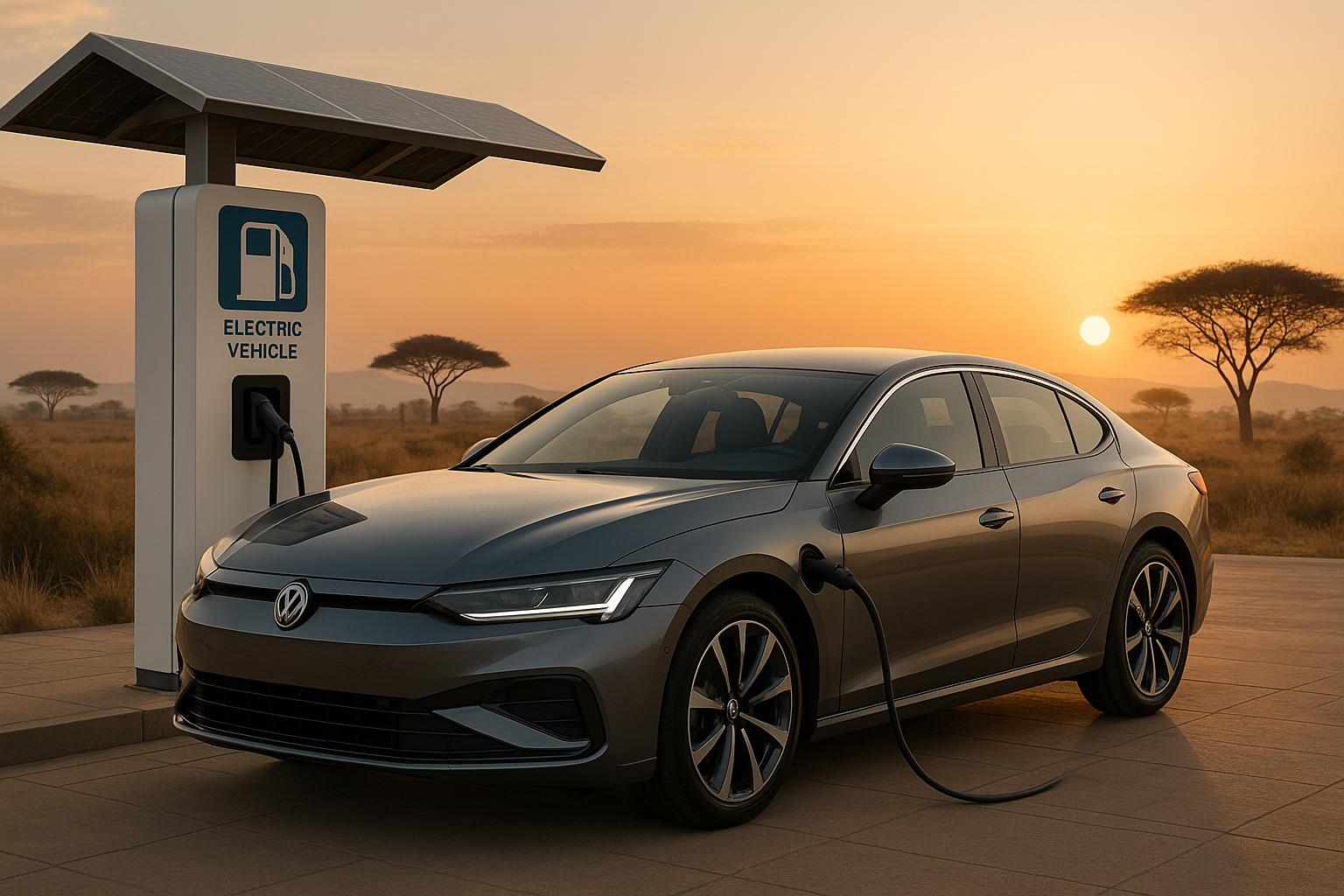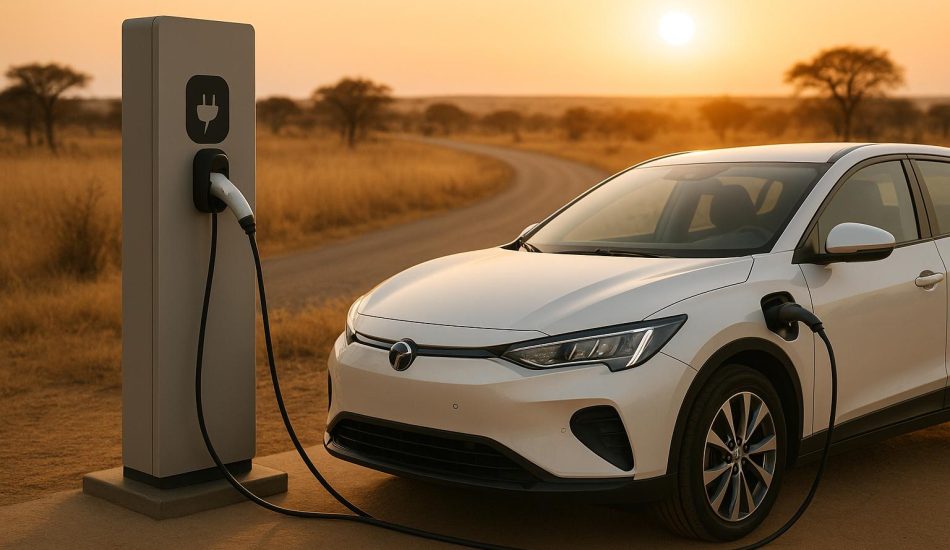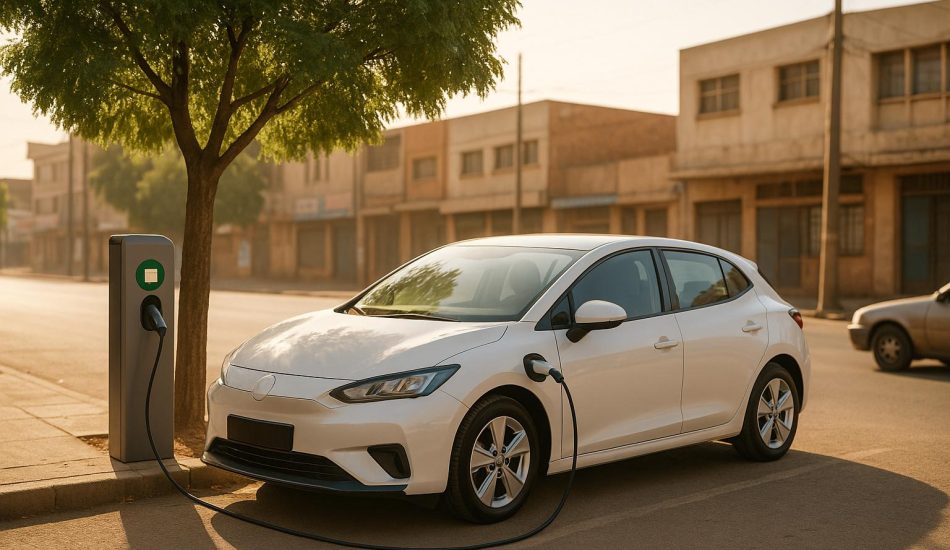
Kenya is seeing a shift toward electric vehicles (EVs), driven by rising fuel costs, environmental concerns, and supportive government policies. This guide provides an overview of EV options, prices, and infrastructure in Kenya as of 2025. Key points include:
- Affordable Options: Pre-owned Nissan Leaf models start at KES 1.8M ($13,400), while budget-friendly electric motorcycles and e-bikes are gaining traction in urban areas.
- Mid-Range Choices: Models like the BYD Atto 3 and Hyundai Kona Electric are priced between KES 3.2M ($23,900) and KES 4.2M ($31,300).
- Charging Infrastructure: Major cities like Nairobi and Mombasa have growing charging networks, with plans to expand nationwide.
- Cost Savings: EVs cost significantly less to operate than gas cars, with fuel savings of over 75% and lower maintenance needs.
EV adoption is growing slowly but steadily, supported by tax incentives and Kenya’s renewable energy focus. Whether you’re considering a new or used EV, options are expanding, making it easier to switch to electric mobility in Kenya.
How practical is having an electric car in Kenya?
Electric Vehicle Models Available in Kenya in 2025
Kenya’s electric vehicle (EV) market in 2025 is shaping up to provide practical and affordable solutions for both city and rural transportation. From compact designs to cost-effective alternatives, the country’s EV landscape is adapting to meet the needs of its diverse population.
Popular EV Models and Their Features
Kenya’s focus isn’t just on traditional cars. Electric motorcycles and e-bikes are emerging as game-changers, especially in bustling urban areas. Their affordability, resilience, and ability to navigate through traffic make them ideal for daily use. Local startups are stepping up with innovative designs, including electric motorcycles, retrofitted buses, and fully electric buses, all aimed at providing efficient two- and three-wheeler options for commuters.
Budget-Friendly EV Options
The electric two-wheeler market was valued at about $3.35 billion in 2023 and is expected to grow to approximately $5.40 billion in the near future. These vehicles, with their lower purchase prices and reduced running costs, are attracting a wide range of buyers. As Kenyan innovators continue to refine their offerings, consumers can expect a broader array of affordable EVs tailored to the country’s unique transportation needs.
Electric Car Prices in Kenya for 2025
When it comes to electric vehicles (EVs) in Kenya, the price tag is just one piece of the puzzle. Costs are shaped by factors like government policies, import duties, and local financing options, making the overall pricing landscape unique.
Price Comparison of Popular EV Models
Kenya’s EV market caters to a wide range of buyers, from budget-conscious shoppers to those seeking premium features. For those looking to dip their toes into the EV world, pre-owned Nissan Leaf models are the most accessible, with prices typically ranging between KES 1.8 million and KES 2.5 million ($13,400 to $18,650). These models are particularly appealing to first-time EV buyers.
In the mid-range category, the BYD Atto 3 has gained traction due to its balance of affordability and features, starting at approximately KES 3.2 million ($23,900). Similarly, the Hyundai Kona Electric and Kia Niro EV fall in the same bracket, with estimated prices ranging from KES 3.5 million to KES 4.2 million ($26,100 to $31,300).
| Vehicle Model | Price Range (KES) | Price Range (USD) | Category |
|---|---|---|---|
| Nissan Leaf (Pre-owned) | 1.8M – 2.5M | $13,400 – $18,650 | Budget-Friendly |
| BYD Atto 3 | 3.2M+ | $23,900+ | Mid-Range |
| Hyundai Kona Electric | 3.5M – 4.2M | $26,100 – $31,300 | Mid-Range |
| Kia Niro EV | 3.5M – 4.2M | $26,100 – $31,300 | Mid-Range |
These prices account for the 25% import duty applicable to all vehicles entering Kenya, along with a reduced 10% excise duty specifically for fully electric cars. This combination of taxes and incentives plays a crucial role in shaping EV affordability in the country.
What Affects EV Prices
Several factors influence EV pricing in Kenya, with government policies leading the charge. The 10% excise duty on EVs, compared to the standard 25% for other vehicles, provides buyers with noticeable savings. This reduction underscores Kenya’s commitment to encouraging cleaner transportation alternatives.
Battery technology is another major factor. Modern lithium-ion batteries, known for their extended range and durability, often drive up the cost of EVs. Vehicles equipped with larger battery capacities tend to have higher upfront prices but offer long-term benefits, especially for those who frequently travel long distances.
Local financing options are also making EVs more accessible. Banks are increasingly offering loans tailored to EV buyers, taking into account the lower operating costs of these vehicles. This helps make monthly payments easier to manage.
Charging infrastructure is another game-changer. Areas with established charging networks see higher demand for EVs, which can impact pricing. Additionally, Kenya’s e-mobility tariff for charging stations helps keep operational costs predictable, improving the overall value of EV ownership.
Looking ahead, Kenya’s passenger car market is expected to generate around $89.3 million in revenue by 2025, with electric and hybrid vehicles playing a key role in this growth. As more manufacturers enter the market, competition is driving prices down, offering buyers more choices and better deals.
sbb-itb-99e19e3
Where to Buy Electric Cars in Kenya
Looking to buy an electric car in Kenya? Knowing where to shop is just as important as understanding the available models and pricing. One standout option is EV24.africa, Kenya’s leading online platform for electric vehicles. They offer transparent pricing, flexible financing plans, dependable delivery options, and strong after-sales support.
Trusted EV Dealership and Platform
EV24.africa boasts a wide selection of verified electric vehicle models from top manufacturers like Tesla, BYD, Volkswagen, XPeng, Leapmotor, Changan, Wuling, Mercedes-Benz, Citroën, and Peugeot. The platform handles everything for you – from shipping and customs clearance to local registration. Whether you need port-to-port or door-to-door delivery across Africa, they’ve got you covered.
Some of their current offerings include:
- BYD Atto 3: Priced at $47,500
- BYD Dolphin Active: A budget-friendly option at $11,800
- Dongfeng eπ 008 EV: Another popular choice
When choosing a dealer, always confirm their business registration, check for a physical showroom, and read customer reviews. Reputable dealers will provide clear warranty terms, upfront pricing, and reliable after-sales service.
Once you’ve found a trustworthy source, the next decision is whether to go for a new or used EV.
New vs. Used EVs: What to Consider
After picking a reliable platform, it’s time to weigh the pros and cons of new versus used electric vehicles. Both options come with their own advantages, depending on your budget and driving needs.
New EVs
New electric cars offer cutting-edge technology, full manufacturer warranties, and the peace of mind that comes with being the first owner. For example, models in the BYD Dolphin range are priced between $30,115 and $49,420, including duties and VAT. These vehicles often include:
- Comprehensive warranties (typically 8–10 years for battery components)
- Advanced safety features
- Improved charging capabilities
- Regular software updates
Used EVs
If you’re looking for a more affordable way to switch to electric, used EVs are a great option. EV24.africa offers several models under $15,000. However, keep in mind that older lithium-ion batteries may have reduced capacity, which could affect the car’s range. Warranty coverage might also be limited or expired, potentially leading to higher repair expenses.
When deciding, think about your driving habits, budget, and comfort with risk. If you frequently travel long distances or want the latest features, a new EV could be worth the investment. On the other hand, if you mostly drive in the city and want a more budget-friendly option, a well-maintained used EV can be a smart choice – while also contributing to a greener lifestyle.
Factors Affecting EV Access in Kenya
Several factors shape how accessible electric vehicles (EVs) are to Kenyans. Understanding these elements can help buyers make informed decisions and highlight areas where EV adoption can improve across the country.
Charging Stations and Infrastructure
Charging infrastructure is one of the biggest factors influencing EV adoption, and Kenya has made strides in this area. At present, most charging stations are concentrated in major cities like Nairobi, Mombasa, and Kisumu, with plans underway to expand coverage nationwide.
Kenya Power has committed KSh 258 million over three years to develop charging hubs, initially focusing on urban areas. Beyond government efforts, private companies are stepping in to accelerate progress. For instance, Roam has partnered with retailers like Quickmart to install charging stations at convenient locations where people already shop and run errands.
For prospective EV buyers, this means that urban residents currently enjoy better access to charging facilities compared to those in rural areas. However, ongoing expansion efforts aim to bridge this gap. Before purchasing an EV, it’s a good idea to assess the availability of charging stations in your area and along your usual travel routes.
This growing charging network, combined with financial incentives, is paving the way for a more affordable EV ownership experience.
Financing and Support Services
Support services and favorable policies are helping to offset the high upfront costs of EVs, which is a significant barrier for many buyers.
The Kenyan government has introduced tax incentives to make EVs more affordable. For example, buyers can save hundreds of thousands of shillings on a car valued at KSh 2 million, thanks to reduced taxes compared to similar-sized petrol cars. However, potential policy changes, such as removing VAT exemptions for lithium batteries, could increase costs and slow adoption.
Comprehensive warranties are another key factor, addressing common concerns about battery replacement costs and offering peace of mind to buyers.
Once the initial purchase is made, EVs also provide ongoing financial benefits that make them an attractive long-term option.
Cost of Ownership: EVs vs Gas Cars
While EVs often come with higher upfront costs, their lower operational expenses make them a cost-effective choice over time. Here’s how they compare to traditional gas cars:
| Cost Factor | Electric Vehicle (EV) | Traditional Gas Car |
|---|---|---|
| Fuel Cost per km | ~KSh 3.23 (based on e-mobility tariff) | ~KSh 15.83 (based on current petrol prices) |
| Fuel Savings | Over 75% less than petrol cars | N/A |
| Excise Duty | 10% | 25% to 35% (depending on engine size) |
| Maintenance | Lower costs; no oil changes or spark plugs | Higher costs; frequent maintenance needed |
The difference in fuel costs is striking. An EV with a 6 km/kWh efficiency using Kenya’s e-mobility tariff of KSh 19.35 per kWh costs about KSh 3.23 per kilometer to operate. In contrast, a petrol car achieving 12 km/liter with petrol priced at KSh 190 per liter costs nearly KSh 15.83 per kilometer.
Maintenance is another area where EVs shine. They require minimal upkeep, focusing mainly on tires, wheel alignment, brake pads (which last longer due to regenerative braking), and suspension checks.
Kenya’s reliance on renewable energy adds to the appeal of EVs. Over 90% of the country’s electricity comes from renewable sources, making EVs a cleaner option. Additionally, Kenya Power estimates that 50,000 passenger EVs would consume approximately 187.5 GWh per year, helping to utilize surplus renewable energy generated during off-peak hours.
Despite these advantages, EV adoption in Kenya remains low. In 2024, only 0.18% of newly registered cars were electric, although electric motorcycles fared slightly better, making up just over 7% of new registrations. The high upfront costs, driven by taxes, remain a major hurdle. For example, the BYD Dolphin costs KSh 3.9 million ($30,115) before import duties but rises to KSh 6.4 million ($49,420) once VAT is included.
Key Takeaways
Main Points Summary
Kenya’s electric vehicle (EV) market offers options for every budget, from the affordable Jinpeng Electric Mini Car priced at about $3,800 (KSh 494,000) to high-end models like the BYD Sealion 7, which can cost up to KSh 14.6 million. A popular mid-range choice is the Neta V, available for approximately KSh 4.6 million. It delivers a solid 380-kilometer range and supports fast charging.
EV24.africa makes purchasing EVs in Kenya easier by providing access to major brands, clear pricing, customs clearance, and flexible payment plans. The platform features vehicles from Tesla, BYD, Volkswagen, XPeng, and Mercedes-Benz while also managing local registration.
Although updated tax policies may slightly increase EV costs, government incentives still make these vehicles an economical alternative to similar-sized petrol cars.
With these elements in place, Kenya’s EV market is set for continued growth and development.
What’s Next for EVs in Kenya
Kenya has made significant strides in EV adoption over the past two years. While electric cars currently make up only 0.18% of new vehicle registrations, electric motorcycles have gained more traction, accounting for over 7% of registrations.
The country is also expanding its EV infrastructure. New charging hubs are being developed, and partnerships like those between Roam and Quickmart are adding charging stations at retail locations for greater convenience.
Supportive policies are further encouraging growth. Initiatives such as green number plates and priority parking aim to boost EV adoption. Additionally, Kenya’s reliance on renewable energy – over 90% of its electricity comes from clean sources – makes it an ideal setting for EV expansion.
Public transportation is also embracing electrification. Companies like BasiGo plan to introduce more than 1,000 electric buses in the near future. Projections suggest that with 50,000 passenger EVs on the road, they could consume 187.5 GWh annually, helping to utilize Kenya’s surplus renewable energy during off-peak hours.
These advancements highlight a promising future for EVs in Kenya, with infrastructure, policy, and renewable energy aligning to support this growth.
FAQs
What are the key advantages of switching to an electric car in Kenya, especially in terms of cost and the environment?
Switching to an electric car in Kenya offers a range of benefits that are hard to ignore. One of the biggest perks is saving money. Electric vehicles (EVs) cost less to run compared to traditional gas-powered cars. You’ll spend less on fuel, and maintenance is cheaper too – EVs have fewer moving parts, which means fewer things that can break or wear out.
From an environmental perspective, EVs are a game-changer. They produce zero tailpipe emissions, making them a cleaner option for getting around. By choosing an electric car, drivers in Kenya can help cut down on air pollution and take a step toward addressing climate change – all while enjoying the financial benefits over time.
What is the current state of Kenya’s charging infrastructure for electric vehicles, especially in areas outside major cities like Nairobi and Mombasa?
Kenya’s electric vehicle charging infrastructure is still in its infancy, with most stations clustered in urban centers. However, there’s momentum to change that. Plans are in motion to set up 45 new charging stations across six counties, including Nairobi, Kisumu, Nakuru, and Mombasa.
In addition, the government is focusing on major highways, aiming to place a charging station every 25 kilometers. While it’s a gradual process, these initiatives signal progress toward making EV ownership feasible for people beyond the main urban hubs.
What financing options are available for buying electric cars in Kenya, and how do they affect affordability?
Electric vehicles (EVs) are becoming more accessible in Kenya, thanks to various financing options like loans and leasing plans. These solutions help ease the initial cost, allowing buyers to spread payments over time.
For those hesitant about full ownership, leasing offers a more flexible path. On the other hand, loans from banks or financial institutions provide structured repayment plans tailored to different budgets. Both approaches are making EVs a more practical and appealing option for a wider range of consumers.




